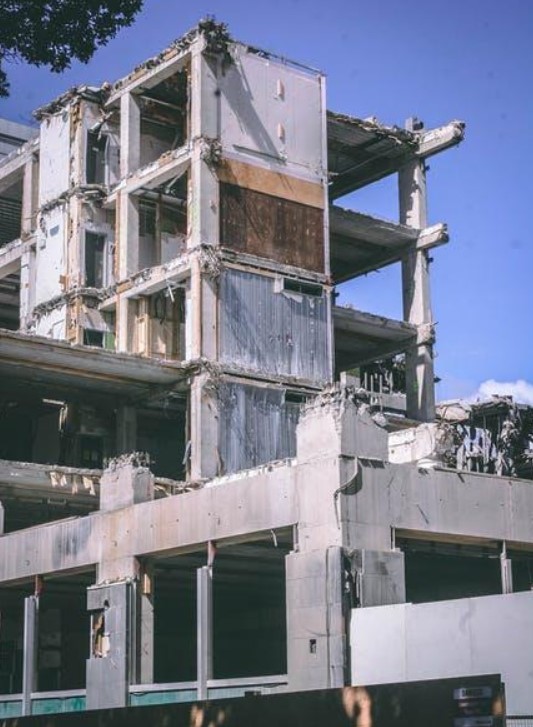Vacant buildings are often considered a liability rather than an asset. Property owners have the option of renovating or removing the building.
If you choose to remove then demolition is the best course of action. Controlled demolition is the use of explosives to demolish a building or structure in a controlled way. Controlled demolition is often used in instances where it is critical to reduce the danger of damage to nearby property or infrastructure.
Keep reading to learn more about the process of controlled demolition.
Pre-planning
Pre-planning for controlled demolition is incredibly important. A thorough inspection must conduct of the structure and its environment must:
- identify all the surrounding hazards
- assess the building’s stability
- identify any necessary precautions
Detailed drawings must then be made, specifying, outlining, and diagramming the materials and proposed demolition procedures. The demolition professional must then calculate how the building will shift—also the failure under a specific sequence of placed explosive charges.
The blasting pattern then has to approve before it’s put into action. Once it’s approved, the operator needs to be precise in his or her execution. Ensure that the structure comes down in the desired way.
Pre-planning is key for controlled structure demolitions; without detailed diagrams and calculated executions. The results of a controlled demolition can be hazardous and irreversible.
Demo Setup
The setup for a controlled demolition begins weeks in advance. Once the location’s chosen, large steel frames are erected around the structure and held in place with cables and jacks.
A survey of the structure’s conducted to chart the point of entry and specific targets to maximize the collapse. Next, precise cuts are made with torches or wire saws in specific areas. To weaken the load-bearing elements of the structure and lessen the shock wave created by the collapsing building.
Once the setup is complete, the demo crew sets the charges and engineers establish their firing sequences. Special attention’s paid to the timing of the charges to ensure maximum efficiency and the desired result. The result is the successful destruction of the target structure.
Pre-blast Preparation
Controlled demolition is the process of preparing and demolishing a structure in the safest way possible. Preblast preparation is the first and most important step in the controlled type of demolition process.
It consists of an inspection of the structure to determine its stability. Followed by the removal of any hazardous or non-structural materials. Next, the structure must relieve itself of its dead load to ensure it won’t collapse. This can include:
- temporary support systems
- shoring
- steel bracing
Then, reinforcing steel that will interfere with the demolition must remove. Finally, the demolition materials are cut and removed in an order that will provide maximum safety and efficiency.
The entire process is monitored and sequenced through the use of specialized explosive charges. With pre-blast preparation, controlled demolition is a safe and efficient process to remove any unwanted structure.
Also Read:
Detonation
Controlled demolition is the process of collapsing a structure and minimizing the amount of collateral damage for a specific purpose. In essence, it is the systematic destruction of a building through demolition by implosion.
The process starts with the placement of the explosives at various points in the building followed by detonation. Detonation is the process by which an explosive is set off using a detonator. This causes a chemical reaction that leads to a rapid reaction of the explosive material thus releasing a great amount of energy.
After the detonation of the explosives, the building is brought down with precision and safety. Also, keeping the debris within a predetermined small area.
Planning for controlled demolition is a painstakingly precise process. Since the explosives must place in exactly the right spots to ensure the structure falls in exactly the right way. With controlled demolition, a wrecking company located here can bring down any structure. With minimal environmental impact and keep people living nearby safe.
Post-blast Checks
Controlled demolitions use explosives and linear-shaped charges to destroy a structure in a manner that is pre-planned and calculated. Upon initiation of the explosives, a post-blast check was conducted to ensure that the structure was demolished as intended. Post-blast checks involve inspecting things like the:
- condition of the surrounding
- potential hazards
- debris
This ensures the safety of the surrounding environment, residents, and personnel which is critical in controlled demolition.
Final Clearance and Clean-up
When a building has been demolished through controlled methods, the final clearance and clean-up phase of the entire process begins. This generally includes manual inspection of the area, removing debris, and stabilizing the area with backfilling or leveling.
Final clearance and clean-up must use heavy machinery like skid steers and backhoes to haul away the rubble. Afterward, the area can inspect hazardous materials, like:
- dust
- asbestos
- lead
- mold
- any pollution
Final site inspections are done to ensure that the area is safe and clear for the next project. Chemical and physical tests may be done as well as any other necessary steps. Cancel the demolition permit and secure the land for the next development.
Understanding the Process of a Controlled Demolition
Controlled demolition is an important and valuable tool in construction projects. While complex, it is a safe and reliable method for the safe removal of a structure or a part of a structure. If you’d like to explore controlled demolition further, be sure to reach out and get in touch with the professionals.
Check out our other blog posts for more informative content.
